Today I would like to focus in on the bigger picture by looking at some long term charts for the precious metals complex. I know most enjoy the action by looking at the minute charts, but they’re more likely to morph into something different as time goes on.
On the other hand, looking at the long term charts gives you a clearer perspective since changes come much more slowly and are less likely to morph into something else. A short term bottom on a minute chart vs a long term bottom on a monthly chart have two completely different meanings. If you see a big bottom on the monthly chart you know that the move will last more than just a few weeks or even a few months. It took a lot of smart investors with deep pockets to build out a bottoming formation...and they aren't going to bail out of potions easily.
Minute charts have their place when trying to fine tune or find an entry or exit point. They can also be used when a bigger pattern is building out with smaller individual chart patterns that end up creating the much bigger finished product. I also have a lot of ratio charts to show, which compare gold to the stock markets and some other commodities. These charts will give a feel for how gold is actually doing vs some other areas of the markets. As you know, commodities fell very hard last year and have been basically consolidating since the first of the year. Gold on the other hand, has been chopping out a sideways trading range going nowhere fast.
The first chart I would like to show is a weekly look at gold. You can see the downtrend that has been in place since gold topped out in 2011. When you look at this chart you’re seeing a classic downtrend where a stock is making lower highs and lower lows. To become even remotely bullish about gold, I would have to see it take out the top rail of the downtrend channel and then the top blue rail of the falling wedge. There is also the very important 65-week moving average that has done a pretty good job of holding resistance. 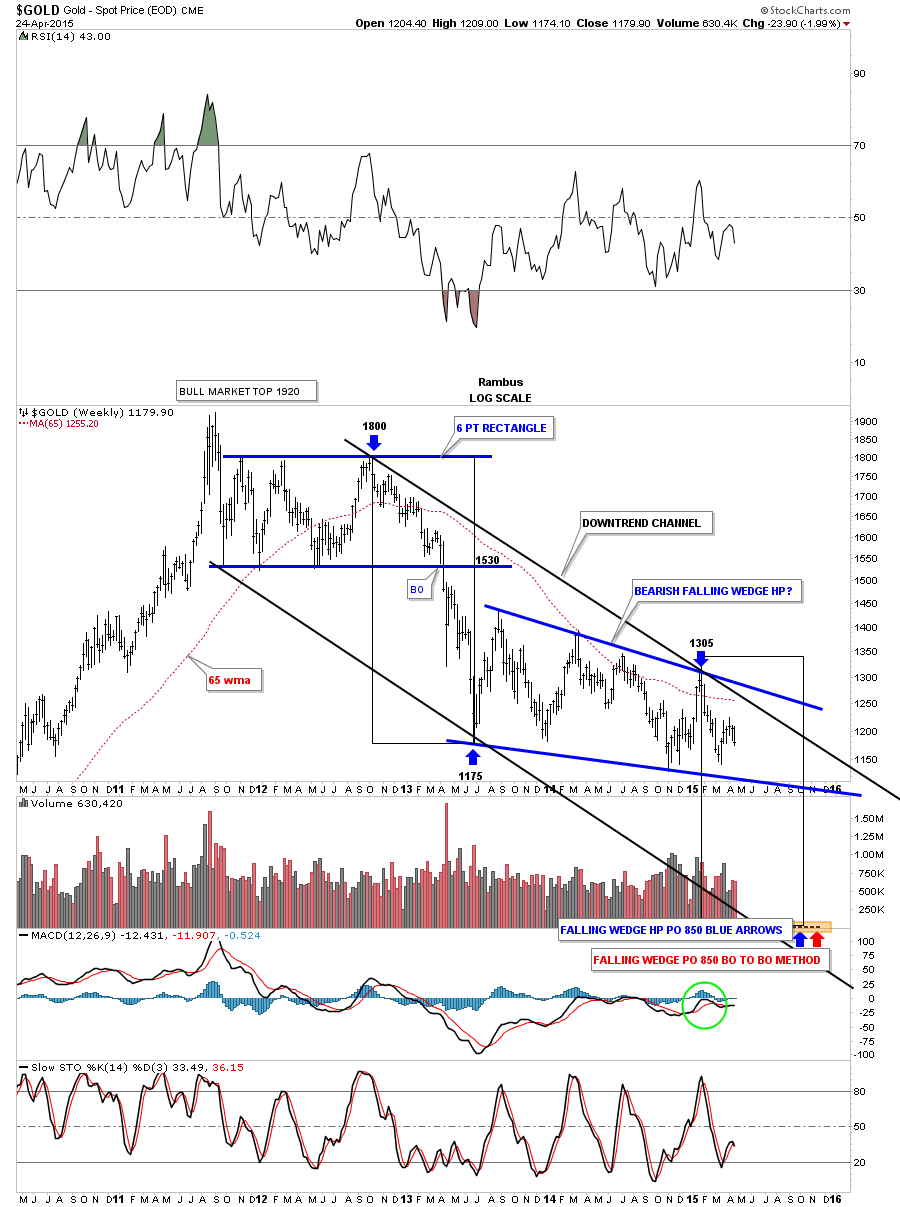 This next, very long term chart for gold shows all the chart patterns that it formed during its bull market years. This chart gives a good idea of how a stock moves as well. As you scan a stock, it’s either building out a topping, bottoming or consolidation pattern. Once one of those patterns is completed you get an impulse move. Rinse and repeat.
This next, very long term chart for gold shows all the chart patterns that it formed during its bull market years. This chart gives a good idea of how a stock moves as well. As you scan a stock, it’s either building out a topping, bottoming or consolidation pattern. Once one of those patterns is completed you get an impulse move. Rinse and repeat.
This is how any stock or market moves. Identifying a top, bottom or consolidation pattern is the hard part. Once you have that figured out, discerning the impulse move is easier compared to all the chopping around before the impulse move actually begins. 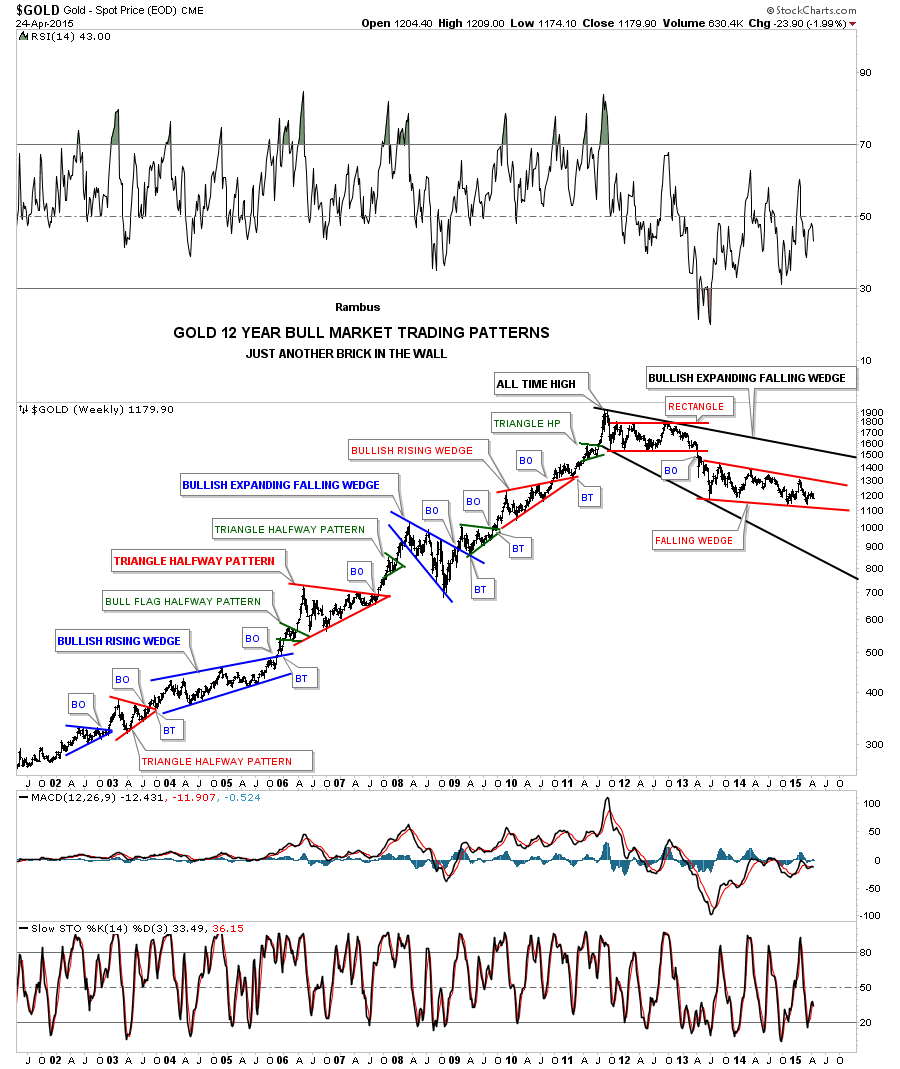 Now let's look at some very long term monthly charts for gold. This first chart is one I’ve been showing for a very long time. It shows gold’s bull markets as an expanding rising channel. Note the area, at the top of the chart, where gold broke below the bottom rail of the expanding rising wedge, then back-tested it from below which built out the right shoulder of the massive H&S top.
Now let's look at some very long term monthly charts for gold. This first chart is one I’ve been showing for a very long time. It shows gold’s bull markets as an expanding rising channel. Note the area, at the top of the chart, where gold broke below the bottom rail of the expanding rising wedge, then back-tested it from below which built out the right shoulder of the massive H&S top.
If you recall, the big neckline is taken from the 2008 H&S consolidation pattern’s neckline which I extended to the right side of this chart. Note how the heavy black neckline also is the same angle as the 2008 left and right shoulders. The chart also shows us the height for the shoulders on the massive H&S top, labeled NL symmetry rail. 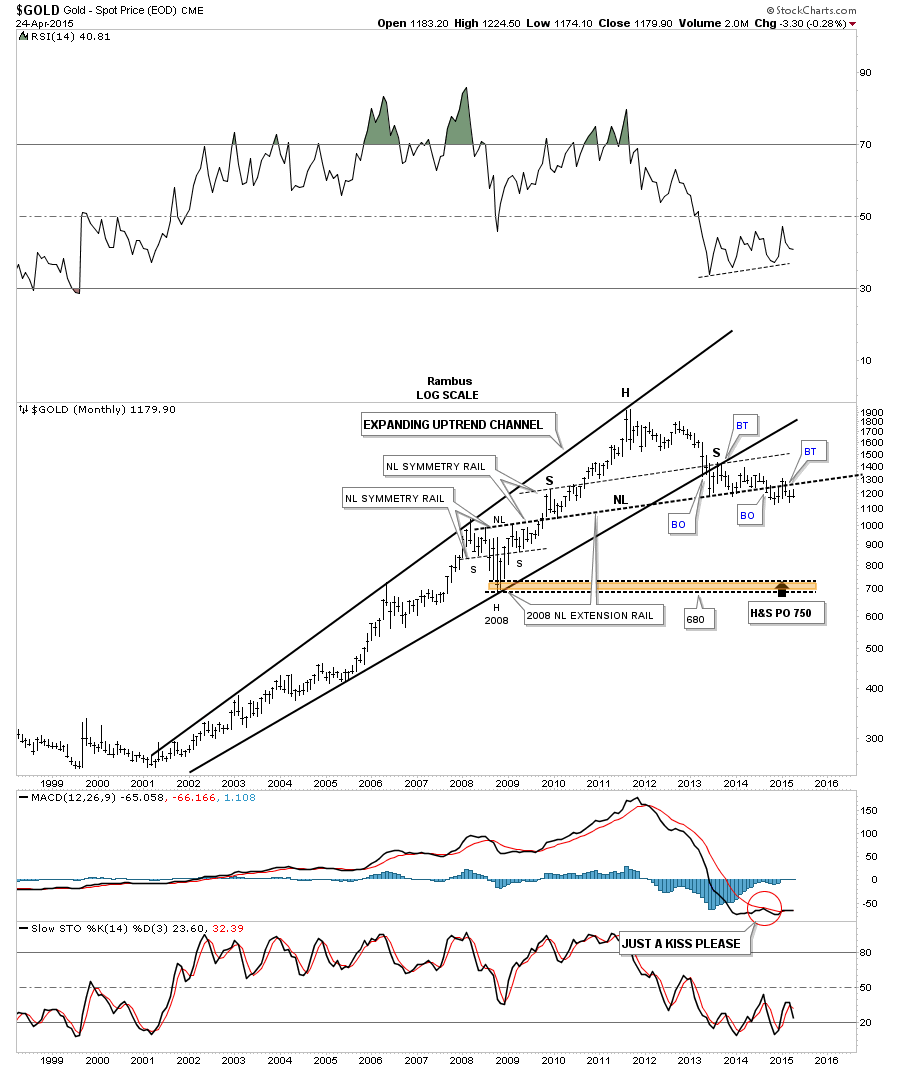 Before we move on to another monthly chart, I would like to show the beautiful symmetry of the 2008 H&S consolidation pattern as I charted it during the big correction. It’s very easy see the symmetry as shown by the colored lines and arrows.
Before we move on to another monthly chart, I would like to show the beautiful symmetry of the 2008 H&S consolidation pattern as I charted it during the big correction. It’s very easy see the symmetry as shown by the colored lines and arrows.
This has to be the most symmetrical H&S pattern I’ve ever seen. The neckline is the heavy black dashed line which gave all the lower symmetry lines their angle. Note the two black arrows that sit on either side of the head, on the neckline.
The best way to see the symmetry is to follow the price action down on the left side of the chart to the green arrow and symmetry line. Before you go to the next arrow, follow the price action down on the right side, starting at the black arrow and following that side down to the green arrow. Then follow the rally up to the grey arrows, then back down to the purple arrows that show the bottoms for the left and right shoulders.
Where the pink arrow is—on the right side of the chart—is the only place where the price action failed to match the left side perfectly. As you can see, it didn’t affect the actual breakout and backtest, which was dead on the money.
You can see how the big black neckline and the top brown symmetry line helped form the H&S consolidation pattern that began in 2010 with the head forming on the big black neckline and the bottom of the left and right shoulders forming on the brown symmetry line. One last note: I have shown in the past how a rising or falling wedge can be part of a H&S pattern. The blue falling wedge shows you a perfect example of this. The left shoulder and head were formed inside the blue falling wedge and the right shoulder was formed after the breakout. This big H&S consolidation pattern is what launched the finally parabolic rally that ended this portion of gold’s bull market. 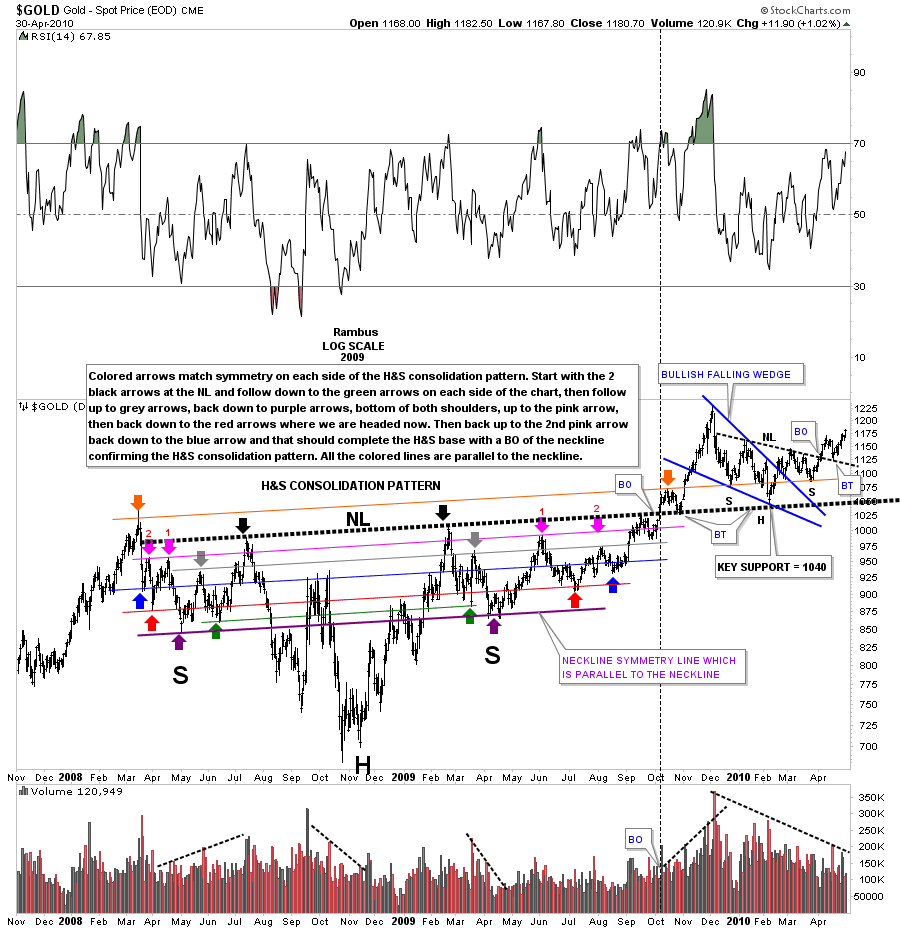 The next chart for gold is a monthly line chart which shows that gold made three big consolidation patterns which were all rising wedges or flags. I explain on the chart how I measured for the blue 6 point bullish rising wedges price objective. You can use that same principal and measure the red bullish rising wedge as a halfway pattern from the breakout of the bottom blue bullish rising wedge. Note the price action on the left side of the chart which is representative of a bull market, compared to the price action on the right side of the chart which is showing us a bear market.
The next chart for gold is a monthly line chart which shows that gold made three big consolidation patterns which were all rising wedges or flags. I explain on the chart how I measured for the blue 6 point bullish rising wedges price objective. You can use that same principal and measure the red bullish rising wedge as a halfway pattern from the breakout of the bottom blue bullish rising wedge. Note the price action on the left side of the chart which is representative of a bull market, compared to the price action on the right side of the chart which is showing us a bear market.  It’s been a while since I showed you this monthly chart for gold that uses the 10 month ema for support and resistance. On the way up it held support like a rock until the 2008 crash.
It’s been a while since I showed you this monthly chart for gold that uses the 10 month ema for support and resistance. On the way up it held support like a rock until the 2008 crash.
On the way down it also has done a good job of holding resistance. This chart also shows the brown shaded support and resistance zones that were taken from the bull market side of the chart. I have to admit that I didn’t think it would take almost two years for the blue falling wedge to mature.
What I think is happening now is that the almost-two-year blue falling wedge is going to be a halfway pattern down to the bear market low. I can see, once gold breaks out from the blue falling wedge, that we’ll see a drop down to the brown shaded S&R zone at the 1034 area and then a backtest move to the underside of the blue falling wedge. Then the capitulation phase begins in earnest. This is how I’m conceptualizing it at this point in time. 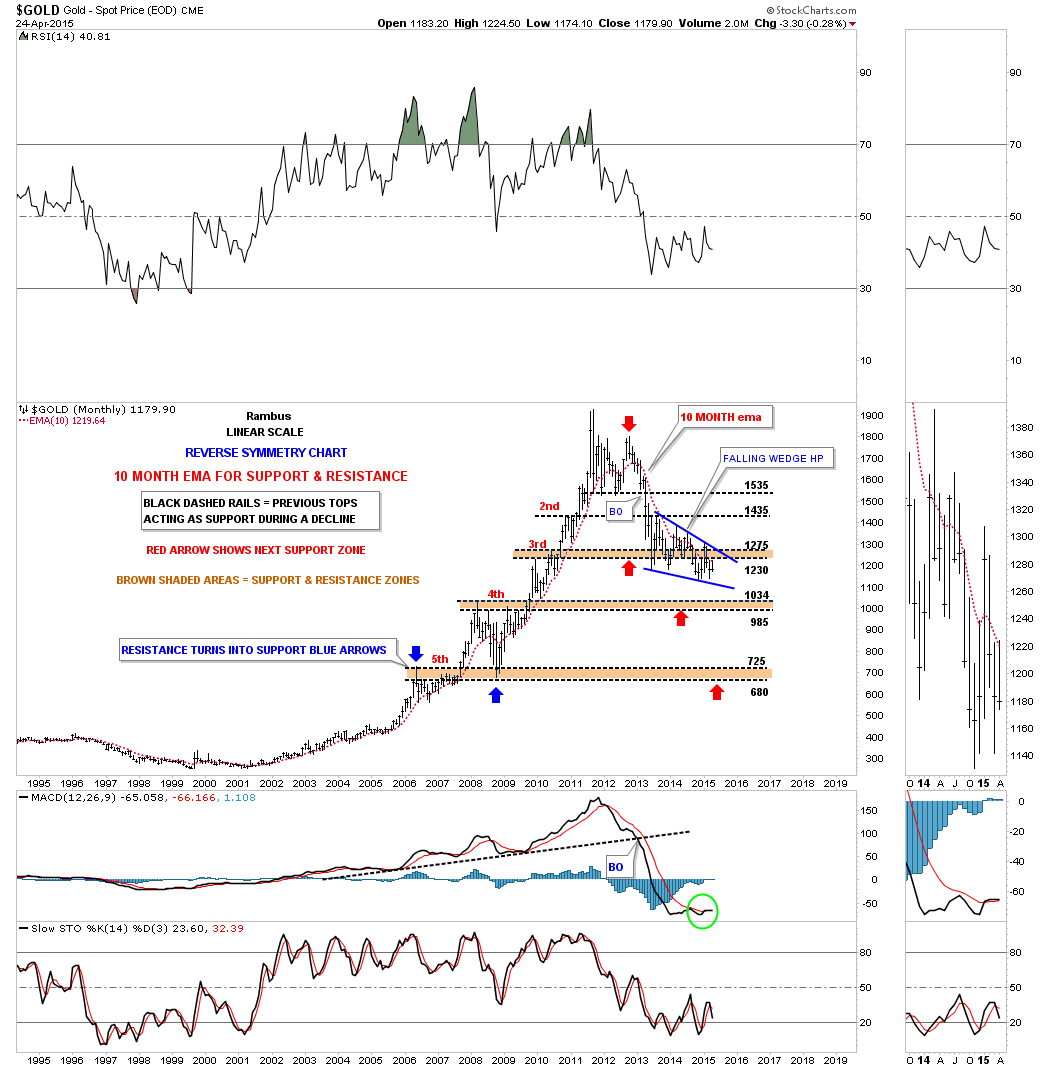 This last, long term look at gold goes all the way back to the 1980 high and shows the bear market that ensued which lasted until to the double bottom was put in place in 2000. You can see how the left side of the chart played a key role in how the bull market found support and resistance.
This last, long term look at gold goes all the way back to the 1980 high and shows the bear market that ensued which lasted until to the double bottom was put in place in 2000. You can see how the left side of the chart played a key role in how the bull market found support and resistance.
Note the neckline at 725 which held resistance on the initial hit in 2007, then declined a little bit and then broke through in grand fashion, but ran out of gas with the onset of the 2008 crash. Gold found support right where you would expect to find it, right on the neckline taken from the first reaction high off of the 1980 bull market. What's interesting is the H&S top. You see at the top of the chart, it has a price objective down to the 725 area which would be a logical place for a bottom of some kind to form. 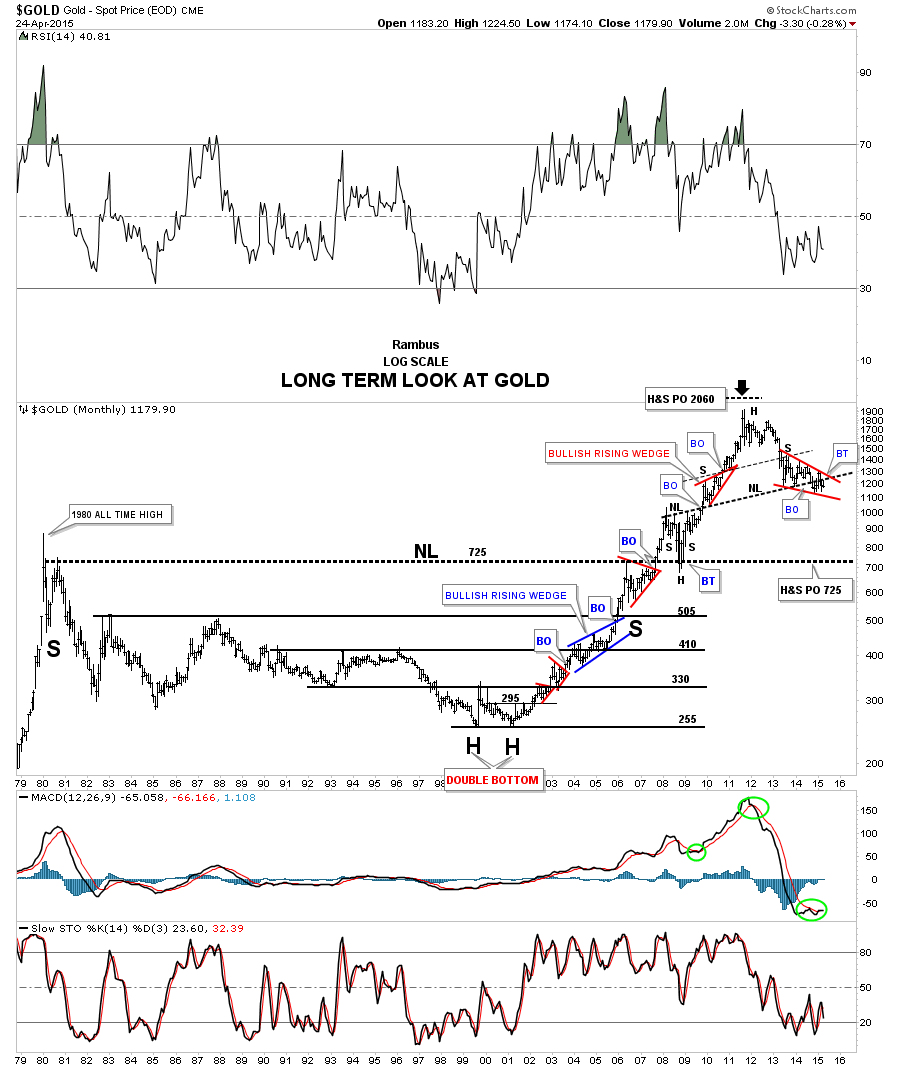 The next chart is a long term daily look at gold that shows the most important moving averages for gold. As of today, gold is trading below all four moving averages.
The next chart is a long term daily look at gold that shows the most important moving averages for gold. As of today, gold is trading below all four moving averages. 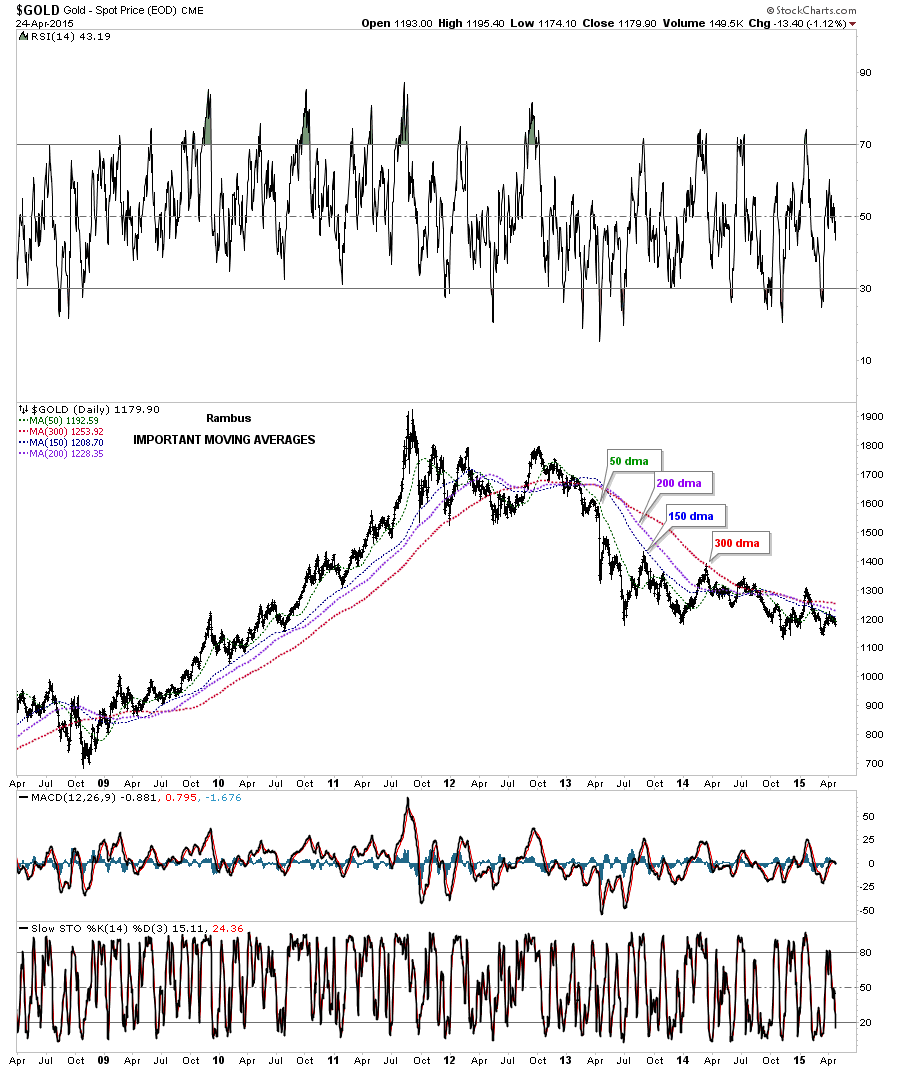 Let's now look at a couple of long term charts for Silver that show the big picture. The first chart is a weekly look which shows that silver built out a H&S consolidation pattern during the 2008 crash, which led to its parabolic run to fifty.
Let's now look at a couple of long term charts for Silver that show the big picture. The first chart is a weekly look which shows that silver built out a H&S consolidation pattern during the 2008 crash, which led to its parabolic run to fifty.
The brown shaded area at the top of the chart shows two price objectives based on two different methods. The little red expanding triangle halfway pattern was the key to finding those price objectives. This chart shows you how much weaker silver has been vs gold as it broke down below its last consolidation pattern, the blue triangle last year. Gold still hasn’t broken below its huge consolidation pattern, but it looks like it’s getting close. As you can see, silver has been in a nice, defined downtrend channel during its bear market. It still remains to be seen, but it looks like silver is building a small H&S consolidation pattern similar to the one we looked at on some of the PM stock indexes. 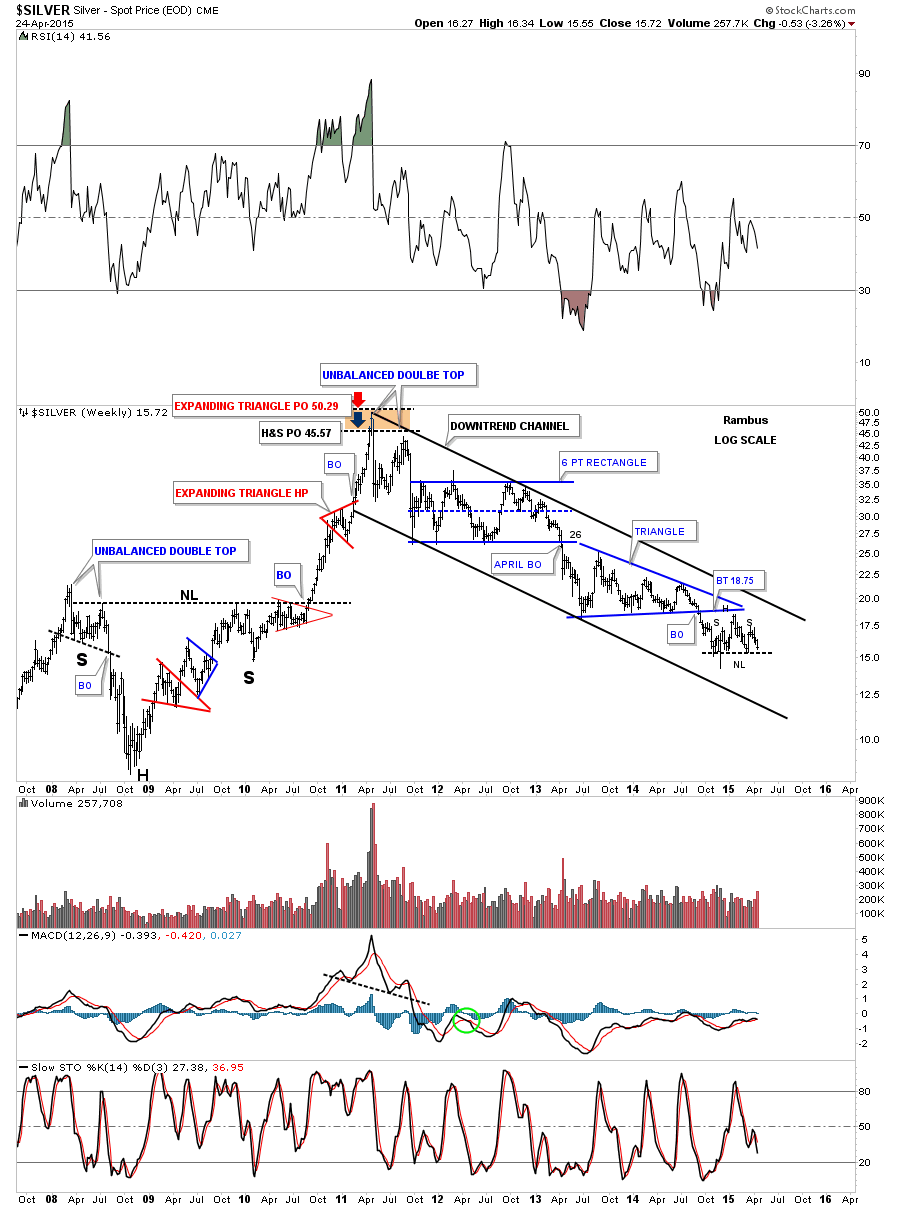 It’s has been a while since I showed you this long term monthly chart for silver which shows a very large H&S top from which the metal has already broken down. The brown shaded S&R zone is where I would expect silver to find support during the next impulse move down.
It’s has been a while since I showed you this long term monthly chart for silver which shows a very large H&S top from which the metal has already broken down. The brown shaded S&R zone is where I would expect silver to find support during the next impulse move down.
Note the neckline symmetry rail which showed the height for the right shoulder that is just a parallel neckline moved up to the top of the left shoulder. It won’t take much of a move down for silver to reach brand new lows going back to 2009 or so. 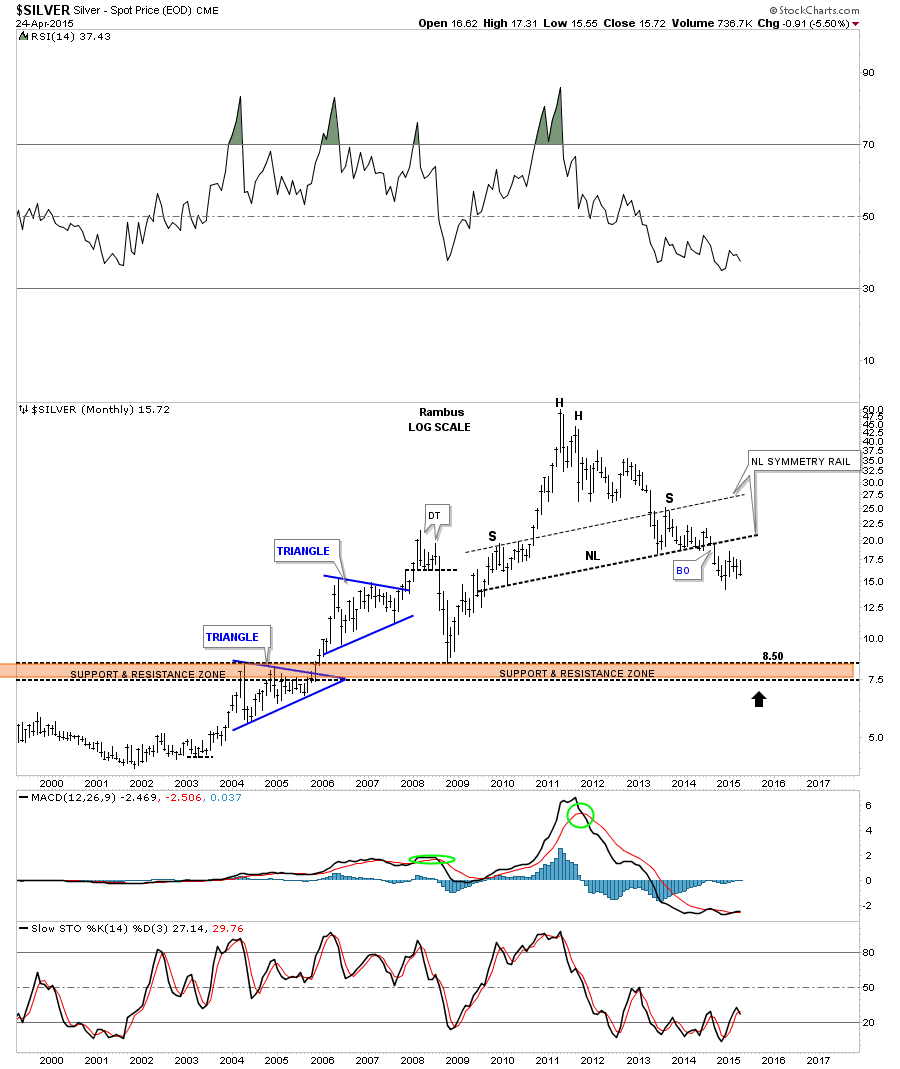 Now some ratio charts. In the first ratio chart, I compare gold to copper. It looks like the ratio may be topping out. The reason I say that is because the price objective of the blue falling wedge is right up there at the top of the big trading range. You can see how quickly this ratio has turned down, meaning copper is outperforming gold at the moment.
Now some ratio charts. In the first ratio chart, I compare gold to copper. It looks like the ratio may be topping out. The reason I say that is because the price objective of the blue falling wedge is right up there at the top of the big trading range. You can see how quickly this ratio has turned down, meaning copper is outperforming gold at the moment.  I have to say I find this next ratio chart, which compares gold to oil, quite interesting. Last year, when oil was in a parabolic decline, this ratio spiked up in a parabolic rally even though gold didn’t really do that much. It was the decline in oil itself that caused this spike in the ratio chart.
I have to say I find this next ratio chart, which compares gold to oil, quite interesting. Last year, when oil was in a parabolic decline, this ratio spiked up in a parabolic rally even though gold didn’t really do that much. It was the decline in oil itself that caused this spike in the ratio chart.
If there was ever a place to look for some reverse symmetry, this chart is showing the setup is there. Right now this ratio is finding some initial support at the previous highs made back in 2012. If this ratio breaks below the brown shaded S&R zone, there will be little in the way to hold back the decline once it gets started. The neckline from the H&S bottom would be the first area to offer some support. 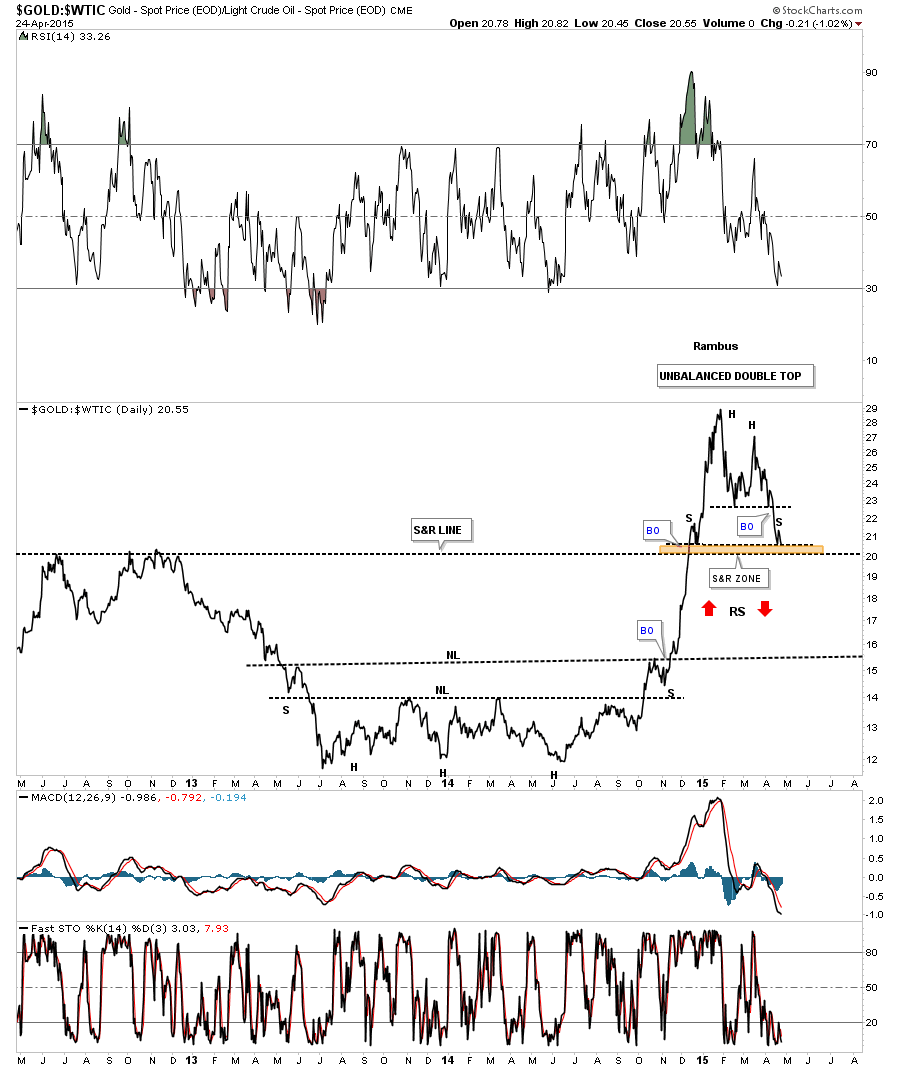 In this next chart, I compare gold to the CRB Index which is holding up the best so far. I put a S&R line just below what could be a top, as shown by the negative divergence on the RSI indicator at the very top of the chart. A top won’t be confirmed though, until the S&R line is broken to the downside. It’s just a possibility right now.
In this next chart, I compare gold to the CRB Index which is holding up the best so far. I put a S&R line just below what could be a top, as shown by the negative divergence on the RSI indicator at the very top of the chart. A top won’t be confirmed though, until the S&R line is broken to the downside. It’s just a possibility right now.  Next I would like to compare gold to silver which shows this ratio rising, which means gold is outperforming silver. What is interesting about this ratio chart is it’s getting up to the top of the 17 year trading range. It has taken four years to go from the bottom, when silver made its parabolic move to 50, to the top of the trading range around the 81 area.
Next I would like to compare gold to silver which shows this ratio rising, which means gold is outperforming silver. What is interesting about this ratio chart is it’s getting up to the top of the 17 year trading range. It has taken four years to go from the bottom, when silver made its parabolic move to 50, to the top of the trading range around the 81 area.  This next, very long term ratio chart compares the INDU to gold so you can see how this ratio works in bull and bear markets. When the ratio is rising, the INDU is outperforming gold.
This next, very long term ratio chart compares the INDU to gold so you can see how this ratio works in bull and bear markets. When the ratio is rising, the INDU is outperforming gold.
Note the parabolic move this ratio had in the 1990s when the INDU's bull market was in full force. Then the reversal of fortunes in 2000, during which the INDU topped and gold bottomed. This ratio bottomed in 2011 at 5.50. I know many goldbugs were looking for the ratio to go down to 1 : 1, as in 1980, but they were left holding the bag waiting for the 1 : 1 ratio to come into play. This ratio chart shows the INDU outperforming gold since the middle of 2011. 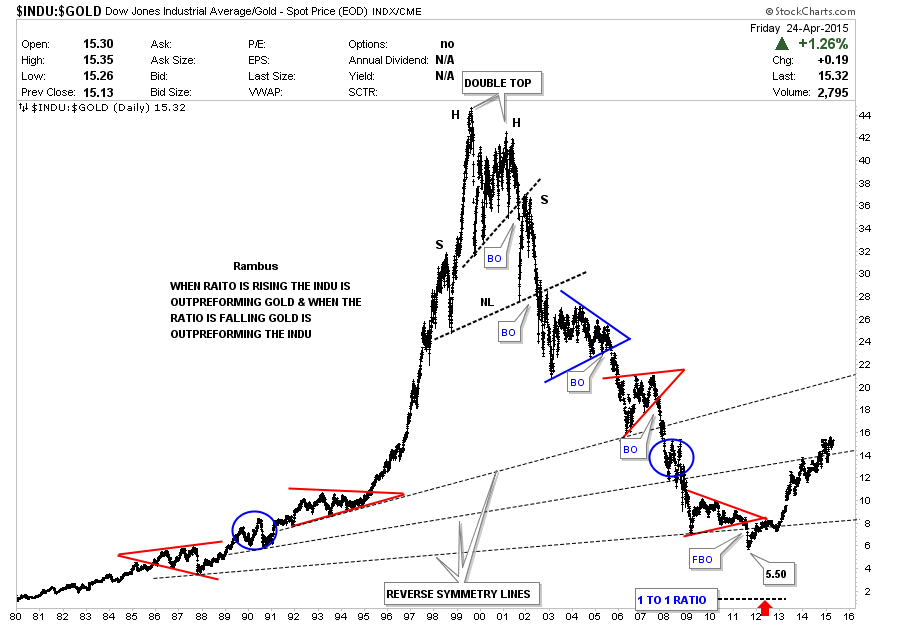 Now a few combo charts. This first one shows gold's price in many of the most important world currencies. What’s interesting, but not unexpected, is that gold in US dollars is the weakest of the currency denominations. As you can see, it’s trading well below its neckline. All the other currencies (yen, euro, CAD, AUD) have had good bounces off their necklines but they look like they could be building out at least a short term top since the first of the year.
Now a few combo charts. This first one shows gold's price in many of the most important world currencies. What’s interesting, but not unexpected, is that gold in US dollars is the weakest of the currency denominations. As you can see, it’s trading well below its neckline. All the other currencies (yen, euro, CAD, AUD) have had good bounces off their necklines but they look like they could be building out at least a short term top since the first of the year. 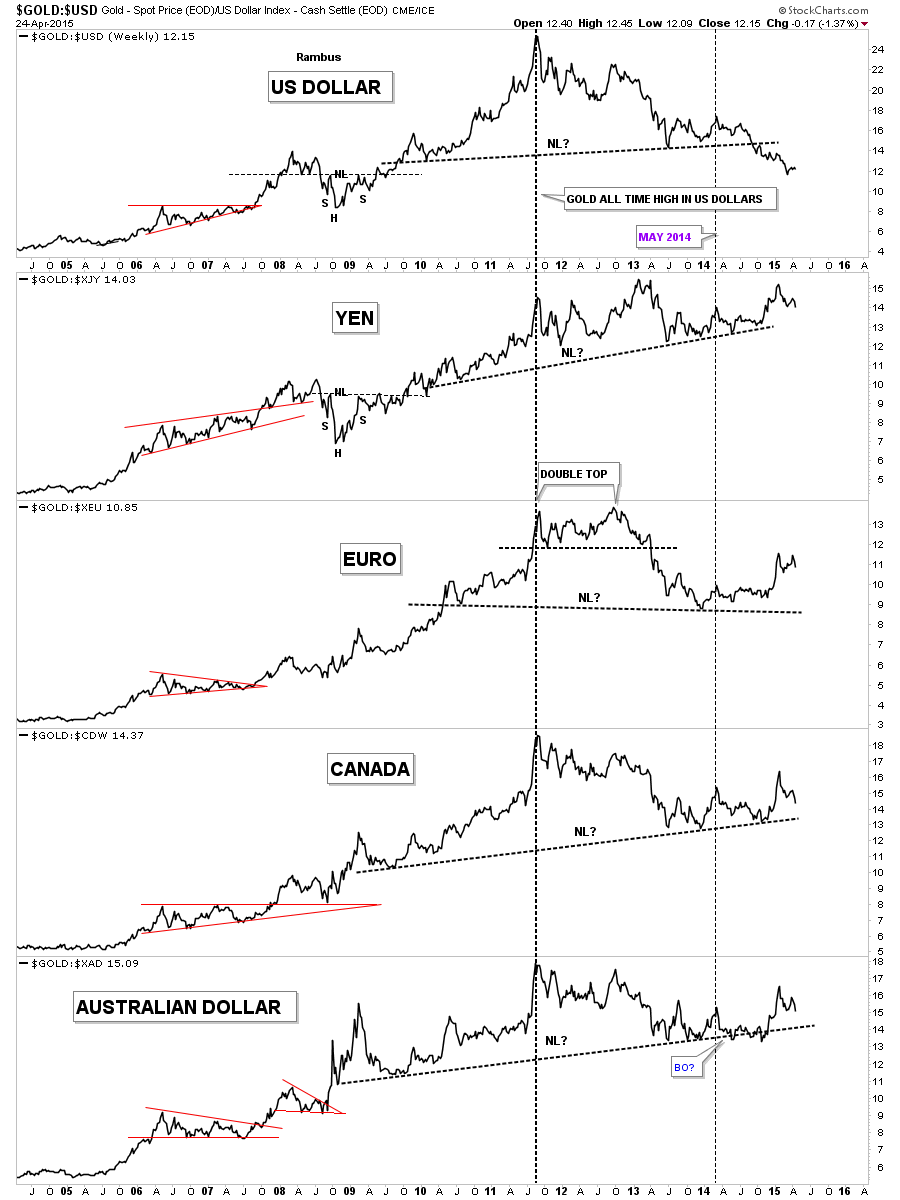 This next combo chart compares gold to the COMPQ which is the tech stocks index. As you can see, it’s making a multi year low this month.
This next combo chart compares gold to the COMPQ which is the tech stocks index. As you can see, it’s making a multi year low this month. 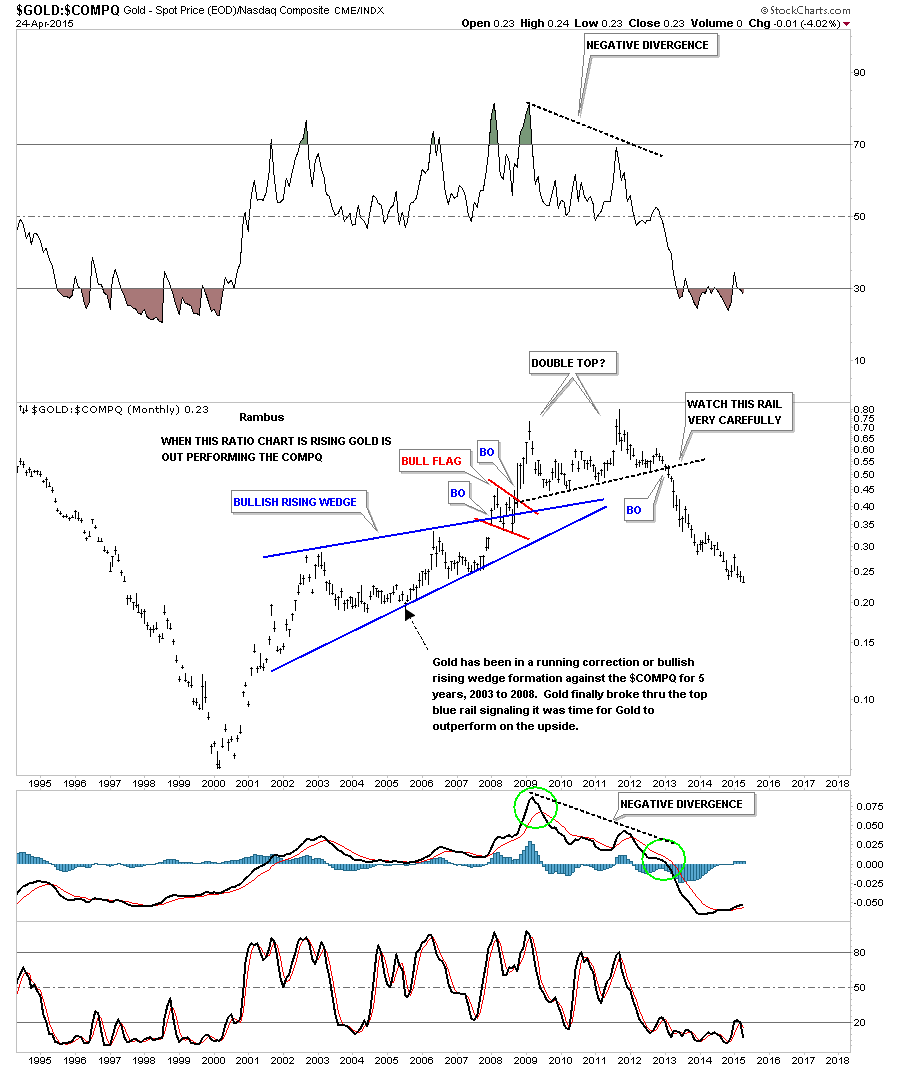 Gold:NDX:
Gold:NDX: 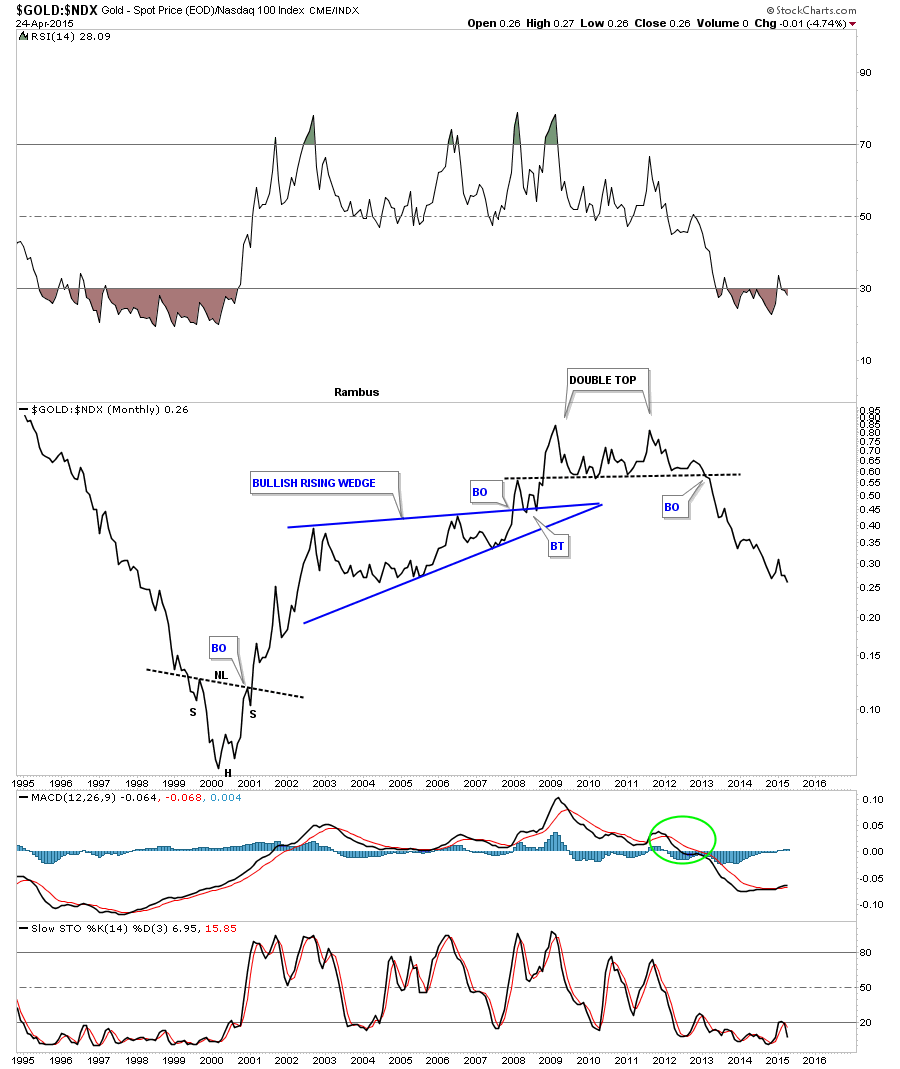 Now let's see how the ARCA Gold BUGS Index (HUI) is performing against the SPX. Some of you may remember this long term monthly chart from when I first showed the price action breaking down below the bottom rail of the blue massive 5 point bearish expanding rising wedge. It still remains to be seen if the time and price rectangles will play out with a low sometime around October of this year. This ratio is going to have to get into gear as there are only about six months left for the ratio to achieve its goal.
Now let's see how the ARCA Gold BUGS Index (HUI) is performing against the SPX. Some of you may remember this long term monthly chart from when I first showed the price action breaking down below the bottom rail of the blue massive 5 point bearish expanding rising wedge. It still remains to be seen if the time and price rectangles will play out with a low sometime around October of this year. This ratio is going to have to get into gear as there are only about six months left for the ratio to achieve its goal.  I've been posting this next combo chart every other week or so, because it shows the HUI on top, the SPDR Gold Shares ETF (ARCA:GLD) in the middle and the iShares Silver ETF (ARCA:SLV) on the bottom. It also shows they are following each other in a similar fashion, not identically, but pretty close.
I've been posting this next combo chart every other week or so, because it shows the HUI on top, the SPDR Gold Shares ETF (ARCA:GLD) in the middle and the iShares Silver ETF (ARCA:SLV) on the bottom. It also shows they are following each other in a similar fashion, not identically, but pretty close.
On the far right hand side of the chart you can see all three are building out potential H&S consolidation patterns. None have broken their necklines yet, but it looks like silver will be the first one to do so as it’s sitting very close to its neckline compared to the other two. 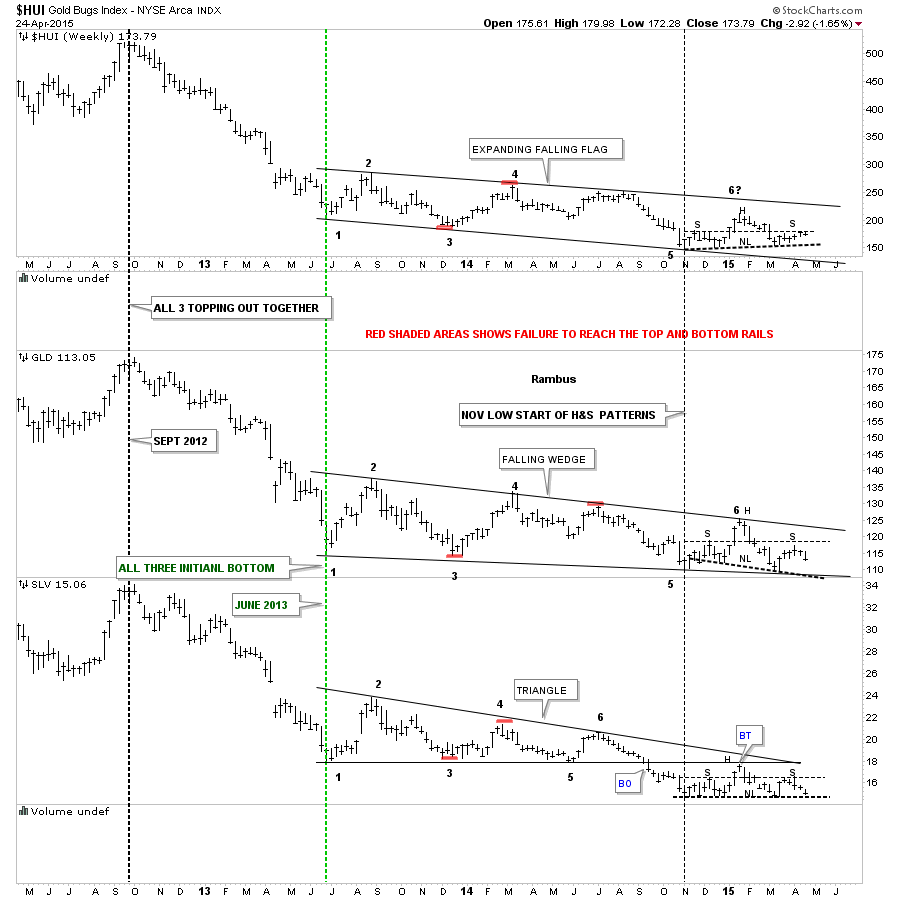 The last combo chart we’ll look at is a line chart that has gold on top and silver on the bottom. On the left side of the chart you can see that silver topped out in April of 2011, while gold didn’t top out until September of that same year. Here you can see how they tend to top and move together even though silver is leading gold lower, via the red dashed vertical lines. The million dollar question is are these two building out a H&S consolidation pattern?
The last combo chart we’ll look at is a line chart that has gold on top and silver on the bottom. On the left side of the chart you can see that silver topped out in April of 2011, while gold didn’t top out until September of that same year. Here you can see how they tend to top and move together even though silver is leading gold lower, via the red dashed vertical lines. The million dollar question is are these two building out a H&S consolidation pattern?
And there you have it . Long Term Charts trump everything . Keep them in mind each day that you trade.
